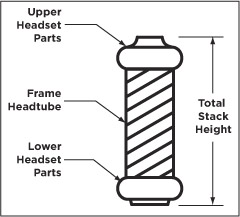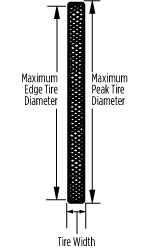INSTALLING A 32MM FORK
You can view a Flash video of the 32MM New Fork Installation if you are installing the fork for the first time.
You can also view a Flash video of the 32MM Replacement Fork Installation if you are replacing an existing fork.
FOX Racing Shox highly recommends that a qualified bicycle technician install your FOX fork on your bicycle. Improperly installed forks are dangerous, and can cause loss of control and serious or fatal injuries. Read this section in its entirety before beginning the installation process of your FOX fork.
To install a FOX 32MM fork on your bicycle:
Remove the existing fork from the bicycle.
Remove the crown race from the old fork.
Measure the steerer
tube length of the existing fork. Transfer this measurement to your new
FOX fork's steerer tube.
If you don't have an existing fork to measure, measure the headset
stack height (shown in the diagram below). Cut your steerer to the same
measurement as the Total Stack Height measurement. Refer to your stem
manufacturer's instructions to be sure there will be enough clamping surface
for the stem. In this case you may need to cut your steerer tube slightly
shorter to allow enough clamping surface so that the stem cap bolt can
pull up on the steerer tube, ensuring a snug fit.

If it is necessary to cut the steerer tube, measure twice and cut once. It is recommended that a cutting guide be used when cutting the steerer tube.
If the steerer has any nicks or gouges, the crown/steerer/upper tube assembly must be replaced. A nick or gouge can cause the steerer to fail prematurely, and cause loss of control of the bicycle and serious or fatal injuries.
Use a crown race setter to install the crown race firmly against the top of the crown. Install the star fangled nut in the steerer tube with a star-fangled nut installation tool to the proper depth (see Star-fangled nut installation depth drawing below).
Install your FOX fork on the bicycle. The headset should be adjust so that it turns freely without drag or free play.
Torque the stem clamping bolts to the stem manufacturer's specifications.
Re-install the brakes and adjust the brake pads according to the brake manufacturer's instructions.
If your fork is a disc brake-only model, route the front disc brake hose through the supplied disc brake hose guide. The disc brake hose guide is assembled as shown in the drawings below.
Tighten the M3 x 12 disc brake hose guide screw with a 2.5 mm-hex key wrench and torque to 8 in-lb (90 N-cm).
Linear-pull brakes (i.e., V-brakes) can be used on FOX 32MM forks equipped with brake posts. Install and adjust linear-pull brakes according to the manufacturer’s instructions. Test brakes for proper operation on flat land. Since FOX 32MM forks use a hangerless lower leg design, cantilever style brakes cannot be used.
Disc brakes with 160 – 203 mm rotors can be used on FOX 32MM forks. Do not use rotors larger than 203 mm. Install disc brakes and torque all fasteners according to manufacturer’s specifications. Install, route and check that all cables or hydraulic hoses are securely fastened to the lower leg and will not move during compression of the fork. It is recommended that new disc brake pads be installed to ensure proper alignment and to minimize drag. Test brakes for proper operation on flat land.
Torque calipers to brake manufacturer's specifications.
Mount the front wheel. Check that the quick-release nuts sit in the fork dropout counterbores. The quick-release should engage four (4) or more threads. Close the quick-release with the lever in front of and parallel to the left fork leg.
FOX 32MM forks will accept tire sizes up to 2.40 inches wide (e.g., WTB MotoRaptor 55/60, 26 x 2.40). Any tire larger than 26 x 2.30 must be checked for clearance using the following method.
With the tire installed and inflated on the rim, measure the following three dimensions:
Maximum Peak Tire Diameter = 686 mm = 27.00 inch
Maximum Edge Tire Diameter = 652 mm = 25.67 inch
Maximum Tire Width = 61 mm = 2.40 inch

Do not use a tire if any measurement exceeds the maximum dimensions shown above. Using larger tires is not recommended and can cause serious or fatal injuries.
eng022